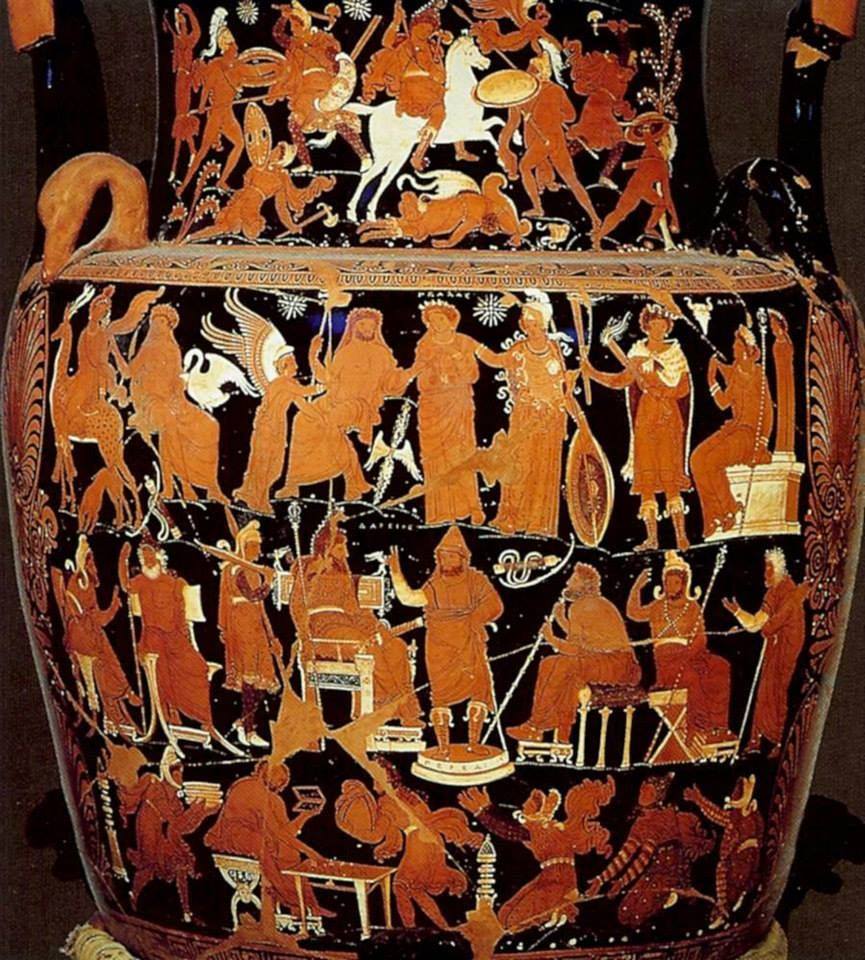
Discovered in 1851 at Canosa di Puglia. It was created by the ‘Darius Painter,’ an Apulian vase painter of the ‘Ornate Style’ in Italian red-figure painting, 340-320 BC. The central band shows Darius The Great King of Persia on his throne, behind whom stand members of his bodyguard, listening to a messenger standing erect in the king’s presence on a circular podium, surrounded by seated dignitaries and, it would seem, his pedagogue, who can be identified as the old man leaning on a stick.
The last frieze shows five Orientals around a seated man, presumably the treasurer; three of them are kneeling, pleading for mercy. Side B, which has a similar structure, shows the myth of Bellerophon: in the upper part, Bellerophon rides Pegasus while a winged Nike crowns him with a laurel wreath; to the left, a naked young man clasps a laurel branch in his hands while in front of him Poseidon, holding his trident in his left hand, sits on a rocky spur. To the right Pan, holding a pyxis and laurel branch, stands opposite Athena, seated on a rock, with a long spear in his left hand. In the middle of the central frieze is Chimera, depicted as a two-headed monster with a leonine body, the head of a lion and a goat, and the tail of a snake, while on the right two Amazons are fleeing; on the left there are two more Amazons, one of whom is attacking.
The main scene has been interpreted in various ways: the identification of the characters is certain since beside each figure appears the name. What has proven more difficult is contextualising it. Some scholars have argued that it shows a scene from Phrynicos’ tragedy in which Persia is about to declare war on Hellas; more recently, an analysis of the compositional structure has led to the conclusion that the space is used symbolically to allude to the actual space of the theatre with the chorus in the lower register, the proscenium in the centre and the tribune of the gods above.
“On the neck of side A there is a painted scene of an Amazonomachia, with Amazons (a Scythian Iranic people) wearing oriental costumes and armed with battle axes engaged in duels – which take place on two levels – against naked Greek warriors wearing crested Corinthian helmets who are equipped with a circular shield and long spear. The figurative decoration of the body is organised into three registers, in each of which there is a seated figure in a central position. In the upper register is Zeus, with a winged Nike kneeling down; to the left are Aphrodite with a swan on her lap and Artemis on a deer, while on the other side are Athena, Hellas, Achates with two torches and Asia, seated on an altar with the image of a deity.
The lowest register shows two fallen Amazons, armed with a spear and an axe respectively, and a marsh bird. On the neck of this side of the picture is a Dionysian scene with a group featuring a Maenad and Silenus on the left, a man and a woman on the sides of the fountain and lastly a second Maenad.
A. Darius Kamali


